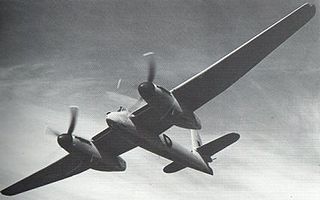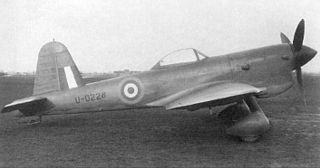Related Research Articles

The Westland Welkin was a British twin-engine heavy fighter from the Westland Aircraft Company, designed to fight at extremely high altitudes, in the stratosphere; the word welkin meaning "the vault of heaven" or the upper atmosphere. First conceived in 1940, the plane was built in response to the arrival of modified Junkers Ju 86P bombers flying reconnaissance missions that suggested the Luftwaffe might attempt to re-open the bombing of England from high altitude. Construction was from 1942 to 1943. The threat never materialised; consequently, Westland produced only a small number of Welkins and few of these flew.

The Avro 679 Manchester was a British twin-engine heavy bomber developed and manufactured by the Avro aircraft company in the United Kingdom. While not being built in great numbers, it was the forerunner of the famed and vastly more successful four-engined Avro Lancaster, which was one of the most capable strategic bombers of the Second World War.

The Fairey Barracuda was a British carrier-borne torpedo and dive bomber designed by Fairey Aviation. It was the first aircraft of this type operated by the Royal Navy's Fleet Air Arm (FAA) to be fabricated entirely from metal.

The Fairey Battle is a British single-engine light bomber that was designed and manufactured by the Fairey Aviation Company. It was developed during the mid-1930s for the Royal Air Force (RAF) as a monoplane successor to the Hawker Hart and Hind biplanes. The Battle was powered by the same high-performance Rolls-Royce Merlin piston engine that powered various contemporary British fighters such as the Hawker Hurricane and Supermarine Spitfire. As the Battle, with its three-man crew and bomb load, was much heavier than the fighters, it was therefore much slower. Though a great improvement over the aircraft that preceded it, its relatively slow speed, limited range and inadequate defensive armament of only two .303 (7.7 mm) machine guns left it highly vulnerable to enemy fighters and anti-aircraft fire.

The Fairey Fulmar is a British carrier-borne reconnaissance aircraft/fighter aircraft which was developed and manufactured by aircraft company Fairey Aviation. It was named after the northern fulmar, a seabird native to the British Isles. The Fulmar served with the Royal Navy's Fleet Air Arm (FAA) during the Second World War.

The Fairey Albacore is a single-engine biplane torpedo bomber designed and produced by the British aircraft manufacturer Fairey Aviation. It was primarily operated by the Royal Navy Fleet Air Arm (FAA) during the Second World War.

The Blackburn B-24 Skua was a carrier-based low-wing, two-seater, single-radial engine aircraft by the British aviation company Blackburn Aircraft. It was the first Royal Navy carrier-borne all-metal cantilever monoplane aircraft, as well as the first dive bomber in Fleet Air Arm (FAA) service. The aircraft took its name from the sea bird which 'divebombs' any potential predators that come too close to its nest.

The Fairey Fox was a British light bomber and fighter biplane of the 1920s and 1930s. It was originally produced in Britain for the RAF, but continued in production and use in Belgium long after it was retired in Britain.

The Hawker Hart is a British two-seater biplane light bomber aircraft that saw service with the Royal Air Force (RAF). It was designed during the 1920s by Sydney Camm and manufactured by Hawker Aircraft. The Hart was a prominent British aircraft in the inter-war period, but was obsolete and already side-lined for newer monoplane aircraft designs by the start of the Second World War, playing only minor roles in the conflict before being retired.

The Fairey Aviation Company Fairey III was a family of British reconnaissance biplanes that enjoyed a very long production and service history in both landplane and seaplane variants. First flying on 14 September 1917, examples were still in use during the Second World War.

The Hawker Henley was a British two-seat target tug derived from the Hawker Hurricane that was operated by the Royal Air Force during the Second World War.

The Miles M.20 was a Second World War British fighter developed by Miles Aircraft in 1940. It was designed as a simple and quick-to-build "emergency fighter" alternative to the Royal Air Force's Spitfires and Hurricanes should their production become disrupted by bombing expected in the anticipated German invasion of the United Kingdom. Due to the subsequent shifting of the German bombing effort after the Battle of Britain towards British cities in what became known as The Blitz, together with the dispersal of British fighter manufacturing, the Luftwaffe's bombing of the original Spitfire and Hurricane factories did not seriously affect production, and so the M.20 proved unnecessary and the design was not pursued.

The Hawker P.V.4 was a 1930s British biplane aircraft built by Hawker Aircraft in competition for a government order for a general-purpose military aircraft.

The Fairey Gordon was a British light bomber and utility aircraft of the 1930s.

The Hawker Horsley was a British single-engined biplane bomber of the 1920s. It was the last all-wooden aircraft built by Hawker Aircraft, and served as a medium day bomber and torpedo bomber with Britain's Royal Air Force between 1926 and 1935, as well as the navies of Greece and Denmark.

The Fairey Hendon was a British monoplane, heavy bomber of the Royal Air Force, designed by Fairey Aviation in the late 1920s. The aircraft served in small numbers with one squadron of the RAF between 1936 and 1939. It was the first all-metal construction low-wing monoplane to enter service with the RAF.

The Short Sturgeon was a planned British carrier-borne reconnaissance bomber whose development began during Second World War with the S.6/43 requirement for a high-performance torpedo bomber, which was later refined into the S.11/43 requirement which was won by the Sturgeon. With the end of the war in the Pacific production of the aircraft carriers from which the Sturgeon was intended to operate was suspended and the original reconnaissance bomber specification was cancelled.

The Fairey Firefly IIM was a British fighter of the 1930s. It was a single-seat, single-engine biplane of all-metal construction. Built by Fairey Aviation Company Limited, it served principally with the Belgian Air Force throughout the 1930s until the outbreak of World War II.

The Fairey Fawn was a British single-engine light bomber of the 1920s. It was designed as a replacement for the Airco DH.9A and served with the Royal Air Force between 1924 and 1929.

The Avro 604 Antelope was a British light bomber which was designed and built in the late 1920s to meet a requirement for a light bomber to equip the Royal Air Force, competing against the Hawker Hart and the Fairey Fox II. It was unsuccessful, the Hart being preferred.
References
Notes
- 1 2 Mason 1994, p. 306
- ↑ Balsved, Johnny E. "Danish Naval History, Naval Aviation" . Retrieved 5 November 2007.
- ↑ Taylor 1974, pp. 305–306.
- ↑ Taylor 1974, p.306
- ↑ One of The Few, Johnny Kent 2008
- ↑ Taylor, H.A. (1974). Fairey Aircraft since 1915. London: Putnam. pp. 303–312. ISBN 0-370-00065X.
- ↑ Lednicer, David. "The Incomplete Guide to Airfoil Usage". m-selig.ae.illinois.edu. Retrieved 16 April 2019.
Bibliography
- Mason, Francis K. The British Bomber since 1914. London: Putnam Aeronautical Books, 1994. ISBN 0-85177-861-5.
- Taylor, H.A. Fairey Aircraft since 1915. London: Putnam, 1974. ISBN 0-370-00065-X.